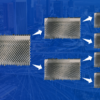VIAVI dials into latest 3GPP standards with 5G data call

5G New Radio (NR) connectivity for the enhanced Mobile Broadband (eMBB) use case will transform the mobile experience for consumers and business across the globe. Delivering mobile data speeds up to 100 times faster than today’s 4G networks, 5G NR will also offer huge improvements in latency (network responsiveness) and reach. It will enable high performance comms services to be extended into a huge range of industries and unlock the capabilities of new and exciting technology trends, such as driverless cars, virtual and augmented reality, and the expanding IoT ecosystem.
The 3GPP Release 15 (Rel-15) standards for 5G new radio (NR) were announced in March this year; a milestone for the telecoms industry and arguably the most important phase of development for equipment vendors and operators. The release sets the stage for 5G NR trials across the industry this year, and early commercial 5G networks throughout 2019 and 2020.
Rel-15 standards state that the first wave of 5G networks and devices will be non-standalone (NSA), meaning that smartphones will connect to a 5G network for data throughput whilst remaining anchored to the 4G (LTE) core – otherwise known as dual connectivity. This delivers a new end-to-end network architecture that allows operators and vendors to leverage their existing 4G infrastructure for the rapid and cost-effective roll-out of 5G coverage and services.
Achieving 3GPP compliance
Understandably, companies across the telecoms industry have put 5G NR development at the centre of their R&D efforts, focussing on how they comply with to the new 3GPP standards in a race to commercialise their networks as rapidly as possible. Testing an NSA dual connectivity 5G data connection is a major part of 5G NR development, and one which vendors and operators are universally progressing in earnest.
VIAVI responded immediately to the 5G NR Rel-15 specifications, ensuring that the TM500 could, within a matter of weeks, verify a 5G NR data connection, in line with the new specs.
Using the TM500, VIAVI has been conducting successful 5G new radio (NR), layer 3, non-standalone calls with a number of operators and network equipment manufacturers across the globe. The calls have achieved both uplink and downlink data transfer, ensuring they are compliant with the recent 3GPP Rel-15 standards. The TM500 was able to validate dual connectivity across different LTE eNodeBs (eNBs), ensuring networks can connect end users to a macro and small cell simultaneously, meaning it could successfully validate dual-connectivity.
End-to-end 5G validation
For the last 10 years, the TM500 has proven invaluable for operators and vendors testing the latest communications standards. It can test network performance as experienced by an end user across multiple cells and different radio technology (for example. 4G and 5G simultaneously), from RF through to the packet core. The TM500 has become the de facto solution for 5G NR testing and has helped companies at different levels of their network development.
VIAVI is now continuing to work with its customers to help them overcome the challenges faced in leveraging 5G NR as rapidly as possible, offering a complete RAN-to-Core testing solution. Our TM500 offers a comprehensive and scalable 3GPP-compliant network test system for base station development. Meanwhile the VIAVI TeraVM, can test and validate virtualised network functions and the virtual evolved packet core (vEPC), by providing scalable real-world application, secure RAN and cybersecurity attack emulation.
Operators and NEMs can benefits from a complete end-to-end testing solution to develop 5G networks and commercialise a huge range of new use cases. We are excited to continue our work to help accelerate 5G roll-outs across the globe, over the next couple of years.


